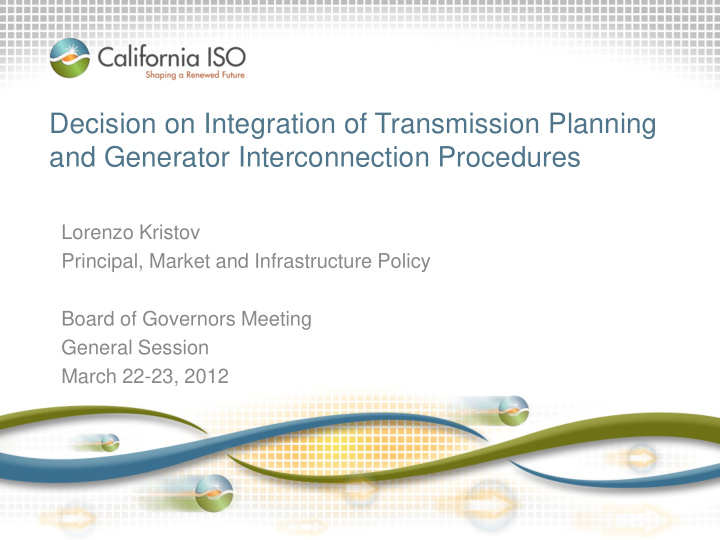



Decision on Integration of Transmission Planning and Generator Interconnection Procedures Lorenzo Kristov Principal, Market and Infrastructure Policy Board of Governors Meeting General Session March 22-23, 2012
Proposal addresses 3 challenges for generation interconnection procedures (GIP), by integrating GIP with ISO transmission planning process (TPP). 1. Plan and approve major ratepayer funded upgrades under a single holistic transmission planning process Minimize role of GIP in identifying rate-based upgrades 2. Ratepayers will cover interconnection upgrade costs only for projects aligned with TPP resource portfolios Current GIP tariff requires ratepayers to fully reimburse new generation projects for all grid upgrade costs 3. Structure GIP study process to produce realistic results even with extreme interconnection queue volume Slide 2
This proposal is the product of an intensive stakeholder process: • Process began in spring 2011 • Five rounds of ISO proposals • Final proposal posted on 3/9/12 • Active participation by – CPUC Staff – ISO Market Surveillance Committee – Renewable resource developers – Municipals & Investor Owned Utilities • Staff researched other ISOs and RTOs Slide 3
Proposal balances multiple objectives and diverse stakeholder concerns. • Limit ratepayer cost exposure – and – facilitate development of new generation projects – Approve sufficient, but not excessive, rate-based transmission – Provide realistic upgrade needs and costs for projects • Align with bilateral procurement process – and – comply with FERC open access – Enable study results to inform procurement decisions – Allocate rate-based transmission to projects fairly and transparently • Minimize impact of large existing queue on new projects – and – avoid retroactive rule changes – New rules apply to new queue cluster and beyond Slide 4
The central design concept builds on the new “public policy-driven” transmission category created in 2010. • Annually develop generation resource portfolios for TPP – Identify public policy upgrades needed to provide deliverability – Provide MW amounts of deliverability in portfolio areas of grid • Allocate rate-based deliverability to projects based on development milestones (new cluster & beyond) – Projects that obtain rate-based deliverability either do not pay, or post & are reimbursed for most network upgrades – Projects that do not obtain rate-based deliverability must pay for network upgrades without ratepayer reimbursement Slide 5
Timeline for Integrated TPP and GIP 2012/13 TPP 2013/14 TPP 2014/15 TPP Final plan Final plan Final plan Final plan 2011/12 2012/13 2013/14 2014/15 TPP TPP TPP TPP 2012-Q1 2012-Q2 2012-Q3 2012-Q4 2013-Q1 2013-Q2 2013-Q3 2013-Q4 2014-Q1 2014-Q2 2014-Q3 2014-Q4 2015-Q1 Clusters 3-4 GIP Phase 2 Execute GIA Cluster 5 Cluster 5 Projects Cluster 5 Execute window GIP Phase 1 choose GIP Phase 2 GIA A or B Cluster 6 Cluster 6 Projects Cluster 6 Execute window GIP Phase 1 choose GIP Phase 2 GIA A or B Cluster 7 Cluster 7 Projects window Phase 1 choose A or B Page 6
Proposal will have the most significant impact on new interconnection customers. • Each project must make a choice to enter GIP phase 2: – Project requires rate-based transmission (Option A) – Project is willing & able to pay for upgrades (Option B) – Most viable projects – A or B – are eligible for rate-based transmission • Ratepayer exposure to upgrade costs is limited – Rate-based deliverability is allocated to new projects only after reserving capacity for viable existing queue projects – Cash reimbursement for reliability upgrades is limited to $60,000 per MW generating capacity Slide 7
Management recommends the Board approve the proposed TPP-GIP reforms. – New rules can apply this year to new cluster 5 – Establishes TPP as the single process for holistic planning of all major ratepayer funded transmission upgrades – Limits ratepayer risk of stranded transmission costs – Provides realistic upgrade needs and costs for projects in the queue, and to inform renewable procurement process – Creates strong incentives for generation projects to locate in areas preferred by the state for renewable development – Incorporates updated status of existing queue projects before offering transmission capacity to new projects Slide 8
Recommend
More recommend